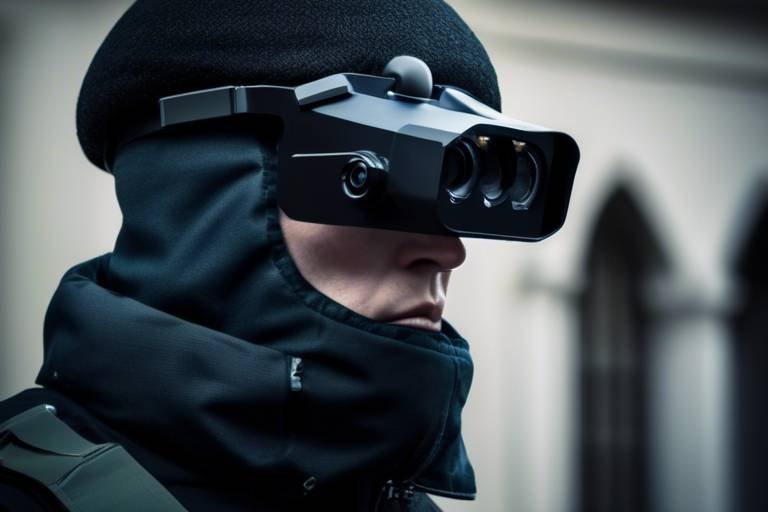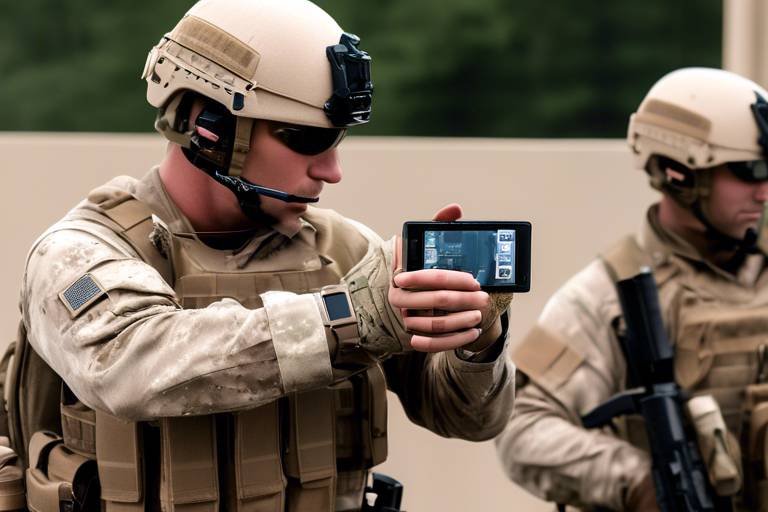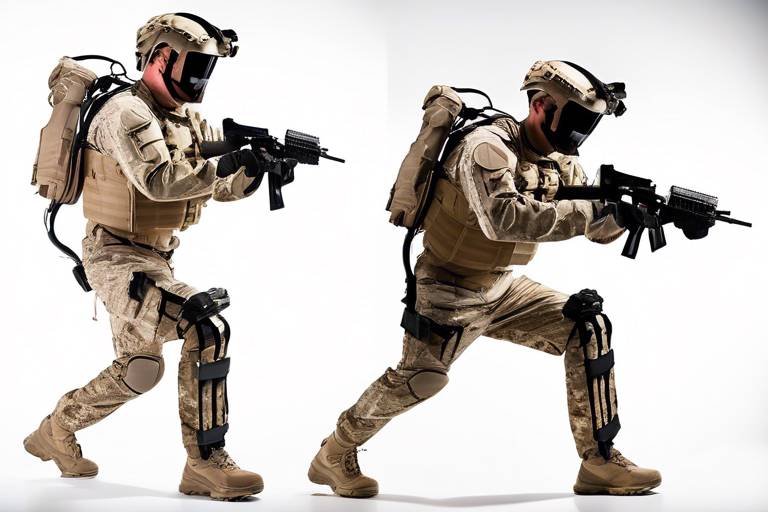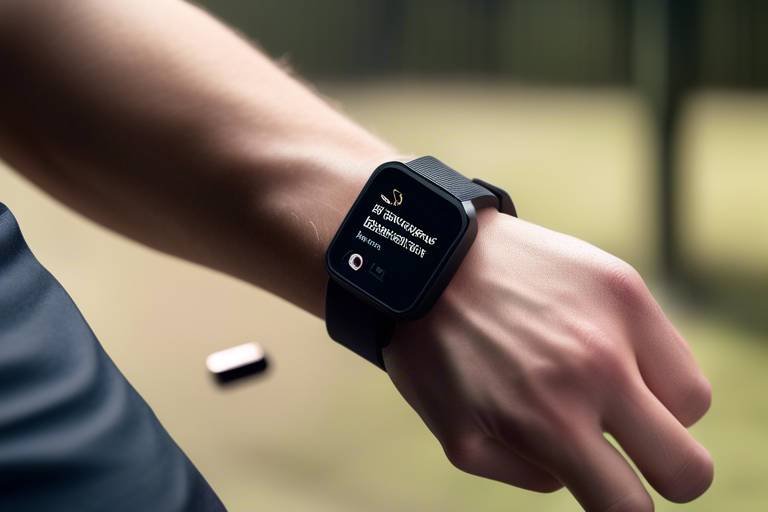Wearable Technologies for Enhanced Communication in the Field
In today's fast-paced world, wearable technologies are not just a trend; they are a revolution in how we communicate and collaborate, especially in professional settings. Imagine being able to share critical information in real-time without fumbling for your phone or laptop. These devices, which include smartwatches, smart glasses, and more, are designed to enhance connectivity and streamline communication among professionals in various fields. Whether you're a construction worker, a healthcare provider, or a field researcher, the integration of wearable tech into your daily operations can significantly improve your workflow and decision-making capabilities.
As we delve deeper into the realm of wearable technologies, it becomes clear that their impact extends beyond mere convenience. They offer solutions that cater to the specific needs of different industries, making communication more efficient and effective. In this article, we will explore the various types of wearable devices, their benefits, challenges, and the future trends that promise to reshape how we interact in professional environments. So, buckle up as we embark on this exciting journey into the world of wearable tech!
Wearable technologies have transformed the landscape of communication, enabling users to share data and connect with others in real-time. These devices are equipped with advanced sensors and connectivity features that allow them to collect and transmit information seamlessly. In various professional environments, from healthcare to logistics, the significance of these technologies cannot be overstated. For instance, a healthcare worker can monitor a patient's vital signs on their smartwatch and relay that information instantly to their team. This level of connectivity not only enhances the quality of care but also saves precious time during critical situations.
There are numerous types of wearable devices available, each tailored to meet specific communication needs. These devices can be categorized based on their functionalities and applications in different fields. Below are some of the most prominent types:
- Smartwatches: These multifunctional devices facilitate communication through notifications, calls, and even health monitoring.
- Smart Glasses: Offering hands-free communication and augmented reality features, these devices improve situational awareness and decision-making.
- Fitness Trackers: While primarily focused on health, they also enable users to connect with their teams and share performance metrics.
Smartwatches serve as multifunctional devices that facilitate communication through notifications and calls. Imagine being in a meeting and receiving an urgent message on your wrist without disrupting the flow of conversation. This capability not only enhances field communication but also ensures that professionals remain connected without being tethered to their smartphones. With features like voice commands and quick replies, smartwatches have become indispensable tools for those who need to stay in touch while on the go.
Smart glasses offer hands-free communication and augmented reality features, allowing users to access information without diverting their attention from their tasks. For example, in manufacturing, workers can receive real-time instructions displayed on the lenses of their glasses, enabling them to perform complex tasks with greater accuracy. This technology not only improves efficiency but also enhances safety, as users can remain aware of their surroundings while accessing critical information.
The advantages of wearable communication technologies are numerous and impactful. From increased efficiency to enhanced safety, these devices are changing the way professionals operate in the field.
Wearable devices streamline communication processes, allowing for quicker decision-making. In fast-paced environments, where every second counts, the ability to receive and respond to information instantly can lead to significant productivity gains. For instance, in emergency response situations, first responders equipped with wearables can communicate vital information to their teams without delay, ultimately saving lives.
Safety is paramount in many fields, and wearable technologies contribute significantly to this aspect. With features like real-time alerts and environmental monitoring, these devices can notify users of potential dangers, such as hazardous conditions or equipment malfunctions. For example, construction workers wearing smart helmets can receive alerts about nearby heavy machinery, reducing the risk of accidents and injuries on site.
Despite their advantages, wearable technologies also face challenges. Issues such as battery life, data privacy, and user acceptance can hinder widespread adoption. For instance, a device that requires frequent charging may not be practical for professionals who are constantly on the move. Additionally, concerns about data security can deter users from fully embracing these technologies.
The future of wearable communication technologies looks promising, with continuous advancements on the horizon. Emerging trends such as AI integration, improved battery technology, and enhanced data analytics are set to further enhance field communication. As these devices become more sophisticated, we can expect to see even greater improvements in connectivity and collaboration among professionals.
Real-world applications of wearable technologies provide insights into their effectiveness. For instance, a logistics company implemented smart glasses for their warehouse staff, allowing them to receive real-time inventory updates and optimize picking routes. This implementation led to a 30% increase in efficiency and a significant reduction in errors. Such case studies highlight the transformative potential of wearable technologies across various industries.
Q: How do wearable technologies enhance communication?
A: Wearable technologies enhance communication by providing real-time data sharing, hands-free connectivity, and instant notifications, allowing professionals to stay connected without interrupting their workflow.
Q: What industries benefit most from wearable technologies?
A: Industries such as healthcare, construction, logistics, and manufacturing benefit significantly from wearable technologies due to their need for efficient communication and safety monitoring.
Q: Are there any privacy concerns with wearable devices?
A: Yes, privacy concerns exist regarding data collection and security. It's essential for users to understand the privacy policies of the devices they use and take necessary precautions to protect their information.
Introduction to Wearable Technologies
Wearable technologies have truly transformed the landscape of communication, acting as a bridge between the physical world and the digital realm. Imagine being able to share critical information with your team in real-time, all while keeping your hands free to focus on the task at hand. This is the essence of wearable devices—they enable seamless connectivity and data sharing, enhancing collaboration in various professional environments.
At their core, wearable technologies are smart devices that can be worn on the body, often integrating sensors and software to collect and analyze data. They range from smartwatches and fitness trackers to advanced smart glasses and health monitors. These devices are not just trendy gadgets; they serve practical purposes, especially in fields where timely communication is crucial. For instance, in healthcare, wearable devices can monitor a patient's vital signs and alert medical personnel instantly if something goes awry.
One of the most significant advantages of these technologies is their ability to facilitate real-time communication. Workers in high-pressure environments, such as construction sites or emergency response teams, can benefit immensely from instant notifications and updates. By receiving alerts directly on their wearable devices, they can make quicker decisions, ultimately leading to better outcomes. The integration of these technologies into everyday tasks is akin to having a personal assistant on your wrist, ready to provide information when you need it most.
Moreover, the significance of wearable technologies extends beyond just communication. They are designed to enhance productivity, safety, and overall efficiency in various industries. As we delve deeper into the world of wearable devices, we will explore the different types available, their unique functionalities, and the myriad of benefits they bring to professionals in the field. The evolution of these technologies promises a future where connectivity and collaboration are not just improved but redefined.
Types of Wearable Devices
When we think about wearable technologies, it's easy to imagine sleek gadgets that sit on our wrists or in our pockets. However, the world of wearable devices is incredibly diverse, catering to a myriad of communication needs across various industries. Each device is crafted with unique features and functionalities that enhance communication, making them invaluable tools in professional settings. For instance, we have smartwatches, which are perhaps the most recognized form of wearable technology. They not only tell time but also act as a communication hub, allowing users to receive notifications and make calls directly from their wrists. This hands-free capability is particularly beneficial for professionals who need to stay connected while on the move.
Another fascinating category is smart glasses. These innovative devices offer a blend of hands-free communication and augmented reality (AR), creating immersive experiences that can significantly improve situational awareness. Imagine a construction worker wearing smart glasses that overlay digital blueprints onto the physical site, allowing them to communicate with team members while keeping their hands free for work. This kind of technology not only streamlines communication but also enhances productivity by providing real-time information right in the user’s line of sight.
Beyond smartwatches and smart glasses, there are also fitness trackers, which, while primarily aimed at health monitoring, can facilitate communication related to wellness in workplaces. For example, in a corporate environment, fitness trackers can help monitor employees' health trends, encouraging a culture of wellness that can lead to better communication about health and safety practices. Similarly, body-worn cameras are gaining traction in fields like law enforcement and security. These devices provide real-time video feeds that can be shared instantly with command centers, ensuring that teams are always connected and informed.
Moreover, hearables, such as smart earbuds, are also making waves in the communication landscape. These devices allow users to take calls, listen to instructions, and even translate languages in real-time, all while keeping their hands free. They are particularly useful in environments where multitasking is essential, such as in warehouses or during field operations.
To summarize, the types of wearable devices are as varied as the fields they serve. Each device is designed with specific functionalities that cater to different communication needs. Here’s a quick overview of some of the most prominent types:
| Device Type | Key Features | Applications |
|---|---|---|
| Smartwatches | Notifications, Calls, Fitness Tracking | Business, Health, Lifestyle |
| Smart Glasses | Augmented Reality, Hands-free Communication | Construction, Healthcare, Field Services |
| Fitness Trackers | Health Monitoring, Activity Tracking | Corporate Wellness, Personal Fitness |
| Body-worn Cameras | Real-time Video, Data Sharing | Law Enforcement, Security |
| Hearables | Audio Communication, Translation | Logistics, Multitasking Environments |
As we continue to explore the realm of wearable technologies, it’s clear that these devices are not just gadgets; they are essential tools that enhance communication and collaboration in the field. Whether you're a healthcare professional, a construction worker, or part of a corporate team, there's a wearable device tailored to your needs, ready to help you connect and perform better in your role.
- What are wearable technologies? Wearable technologies are electronic devices that can be worn on the body, often designed to collect data or facilitate communication.
- How do smartwatches enhance communication? Smartwatches allow users to receive notifications, make calls, and access apps directly from their wrists, enabling hands-free communication.
- What industries benefit from smart glasses? Industries such as construction, healthcare, and logistics benefit from smart glasses by improving situational awareness and facilitating real-time communication.
- Are fitness trackers useful in professional settings? Yes, fitness trackers can promote health and wellness in workplaces, encouraging better communication regarding health practices.
Smartwatches
Smartwatches have become a staple in the realm of wearable technologies, acting as multifunctional devices that not only tell time but also facilitate seamless communication. Imagine being in the middle of a bustling job site or on a fast-paced hospital floor, and rather than fumbling for your phone, you simply glance at your wrist. Smartwatches allow users to receive notifications, make calls, and even send messages without the need to pull out their smartphones. This hands-free capability is a game-changer, especially in environments where every second counts.
One of the standout features of smartwatches is their ability to integrate with various apps that enhance communication. For instance, professionals can receive instant updates from their teams via messaging apps, ensuring that everyone is on the same page. This real-time communication reduces the chances of misunderstandings and delays, ultimately boosting productivity. Moreover, with the integration of voice commands, users can respond to messages or make calls simply by speaking, which is particularly useful when their hands are occupied.
In addition to communication, smartwatches often come equipped with health monitoring features. These functionalities can be crucial in fields such as healthcare and construction, where monitoring vital signs or physical activity can alert professionals to potential health issues or safety hazards. For example, a construction worker's smartwatch might monitor their heart rate and send an alert if it detects an anomaly, allowing for immediate intervention.
Let's take a look at some of the key features that make smartwatches indispensable in various industries:
| Feature | Description |
|---|---|
| Notifications | Receive alerts for messages, calls, and app updates directly on the wrist. |
| Voice Commands | Send messages and make calls using voice recognition technology. |
| Health Monitoring | Track heart rate, steps, and other health metrics that can signal potential issues. |
| GPS Navigation | Access maps and get directions without needing to check a phone. |
As we look to the future, the capabilities of smartwatches are expected to expand even further. Innovations such as enhanced battery life, improved connectivity features, and integration with augmented reality are on the horizon. These advancements will not only enhance communication but also provide professionals with tools that can help them perform their jobs more efficiently and safely.
In summary, smartwatches represent a significant leap forward in wearable technology, especially for communication in the field. They offer a unique blend of functionality, convenience, and safety, making them an essential tool for professionals across various industries. The ability to stay connected while on the go, combined with health monitoring capabilities, ensures that users can focus on their tasks at hand, knowing they have the support of advanced technology right on their wrist.
Smart Glasses
Smart glasses are not just a futuristic gadget; they represent a significant leap in how we communicate and interact with our surroundings. Imagine being able to receive notifications, access information, and communicate—all while keeping your hands free and your eyes on the task at hand. These remarkable devices integrate augmented reality (AR) technology with real-time communication capabilities, making them indispensable in various fields such as healthcare, manufacturing, and logistics.
One of the standout features of smart glasses is their ability to overlay digital information onto the physical world, enhancing situational awareness. For instance, a technician repairing machinery can see schematics directly in their line of sight, reducing the need to consult manuals or mobile devices. This not only saves time but also minimizes the risk of errors. By enabling professionals to maintain focus on their immediate environment, smart glasses can significantly boost productivity and safety.
The applications of smart glasses are vast and varied. In the healthcare sector, surgeons can utilize these devices to view patient data and imaging during procedures without diverting their attention from the operation. In the construction industry, workers can receive real-time updates on project specifications while navigating job sites. Furthermore, smart glasses are increasingly being adopted in training and education, allowing learners to engage with interactive content in a hands-on manner.
However, it’s essential to consider the challenges associated with smart glasses. Issues such as battery life, user comfort, and data privacy can impact their adoption. For example, while many models offer impressive functionalities, their effectiveness can be hampered if they require frequent recharging or are uncomfortable to wear for extended periods. Additionally, the sensitive nature of the data accessed through these devices raises concerns about privacy and security.
As technology continues to evolve, the future of smart glasses looks promising. Innovations in battery technology, lightweight materials, and enhanced AR capabilities are on the horizon, which could lead to broader acceptance and usage across various industries. The potential for smart glasses to revolutionize communication and operational efficiency is immense, and as they become more user-friendly, we can expect to see them become a staple in professional environments.
In summary, smart glasses are not merely a novelty; they are a powerful tool for enhancing communication and efficiency in the workplace. Their capacity to provide hands-free access to vital information while improving situational awareness makes them an asset in any field that values productivity and safety.
Benefits of Wearable Communication Technologies
Wearable communication technologies are not just a trend; they are a game changer in how we interact, collaborate, and operate in various professional environments. Imagine a world where communication is as seamless as a conversation over coffee, regardless of whether you are in a bustling city or a remote construction site. These devices bring an array of benefits that enhance productivity, safety, and overall efficiency. Let's dive into some of the most significant advantages that these technologies offer.
First and foremost, one of the most compelling benefits of wearable communication technologies is their ability to increase efficiency. In fast-paced environments, every second counts. Wearable devices enable instant access to information and communication channels, significantly reducing the time spent on traditional methods like emails or phone calls. For example, a construction manager can receive real-time updates from the site directly on their smartwatch, allowing them to make quick decisions without having to navigate through cumbersome communication processes. This immediacy can lead to faster project turnaround times and a more agile workforce.
Furthermore, these devices often come equipped with features that facilitate hands-free communication. Take smart glasses, for instance. They allow professionals to access critical information while keeping their hands free for other tasks. Imagine a surgeon receiving vital patient information during an operation without needing to look away or interrupt their workflow. This capability not only enhances communication but also ensures that professionals can focus on what truly matters—their work.
Another significant advantage is the enhancement of safety in high-risk environments. Wearable technologies can monitor vital signs, environmental conditions, and even detect falls or accidents. For instance, in the oil and gas industry, workers can wear devices that alert them to hazardous conditions, such as gas leaks or extreme temperatures. This real-time alert system can be the difference between a close call and a serious incident, showcasing how these technologies prioritize worker safety.
Moreover, the integration of wearable communication devices fosters a culture of collaboration. With tools that allow for instant messaging, video calls, and data sharing, teams can work together more effectively, regardless of their physical location. For example, a remote technician can collaborate with an expert in another city through a live video feed, troubleshooting issues in real time. This level of connectivity not only enhances problem-solving but also builds a sense of teamwork that transcends geographical barriers.
Lastly, let’s not overlook the potential for data collection and analysis that wearable devices provide. These technologies can gather valuable insights about workflows, communication patterns, and even employee health metrics. Organizations can leverage this data to identify areas for improvement, optimize processes, and ultimately create a more efficient and healthier work environment. As the saying goes, "What gets measured gets managed," and wearables are paving the way for smarter management strategies.
In conclusion, the benefits of wearable communication technologies are vast and varied. From boosting efficiency and enhancing safety to fostering collaboration and providing valuable data insights, these devices are revolutionizing the way we communicate and work. As we continue to embrace these innovations, the potential for improved connectivity and collaboration in the workplace becomes not just a possibility, but a reality.
- What are wearable communication technologies?
Wearable communication technologies are devices that can be worn on the body, such as smartwatches and smart glasses, designed to facilitate communication and data sharing in real-time. - How do wearable devices enhance safety?
These devices can monitor environmental conditions and vital signs, alerting users to potential hazards and enabling immediate responses in high-risk situations. - Can wearable technologies improve productivity?
Absolutely! By streamlining communication processes and providing instant access to information, wearables significantly boost productivity in various work environments. - Are there any limitations to wearable communication devices?
Yes, challenges such as battery life, data privacy, and user acceptance can hinder widespread adoption, but advancements are continually being made to address these issues.
Increased Efficiency
In today's fast-paced world, efficiency is the name of the game, especially in professional settings where time is often equated with money. Wearable technologies have emerged as game-changers, streamlining communication processes and enabling quicker decision-making. Imagine a construction site where foremen can instantly share updates with their teams without fumbling through their pockets for a phone. With smartwatches and smart glasses, communication becomes seamless, allowing for real-time information exchange and reducing downtime.
Wearable devices are designed to keep professionals connected without the distractions of traditional communication methods. For instance, a nurse can receive patient alerts directly on her smartwatch, ensuring she can respond promptly without having to check a phone or computer. This capability not only enhances productivity but also fosters a more responsive work environment. The implications are vast, as these devices allow workers to focus on their tasks rather than being bogged down by communication barriers.
Moreover, the integration of wearable technologies can lead to significant improvements in workflow. For example, in the logistics industry, delivery personnel equipped with smart glasses can scan packages and access delivery information hands-free. This not only speeds up the delivery process but also minimizes the chances of errors, ultimately leading to higher customer satisfaction. In fact, a study showed that companies implementing wearable tech reported a 30% increase in operational efficiency.
To highlight the impact of wearable technologies on efficiency, consider the following table that outlines the benefits:
| Wearable Device | Efficiency Improvement | Industry Application |
|---|---|---|
| Smartwatch | Instant notifications | Healthcare |
| Smart Glasses | Hands-free operation | Logistics |
| Fitness Trackers | Real-time health monitoring | Sports |
In summary, the advent of wearable technologies is not just a trend; it's a revolution that enhances efficiency across various sectors. By minimizing communication lags and enabling instantaneous access to information, these devices empower professionals to make informed decisions swiftly. The beauty of this technology lies in its ability to integrate into daily tasks, making it an essential tool for anyone looking to boost productivity and streamline their workflow.
Enhanced Safety
In today's fast-paced work environments, safety is not just a priority; it’s a necessity. Wearable technologies are stepping up to the plate, providing innovative solutions that enhance safety measures in various fields. Imagine being in a construction zone where heavy machinery is constantly in use. The last thing you want is to be caught off guard by an unexpected hazard. Wearable devices, such as smart helmets equipped with sensors and communication tools, can alert workers to potential dangers in real-time, ensuring that everyone stays informed and safe.
One of the most significant benefits of these technologies is their ability to monitor vital signs and environmental conditions. For instance, smart vests can track body temperature, heart rate, and even exposure to harmful gases. If any of these metrics fall outside of safe parameters, the device sends immediate alerts to the user and their supervisors. This proactive approach not only protects individual workers but also fosters a culture of safety within the organization.
Moreover, the integration of wearable technologies in safety protocols can lead to quicker emergency responses. In critical situations, such as accidents or health emergencies, wearables can provide crucial data to first responders. Imagine a scenario where a construction worker suffers an injury; their smartwatch can automatically send location data and health information to emergency services, significantly reducing response time. This feature is especially vital in remote locations where access to traditional communication methods may be limited.
The impact of wearable technologies on safety extends beyond individual users. Organizations can collect and analyze data from these devices to identify trends and areas for improvement. For example, if multiple workers report safety alerts from specific equipment or areas, management can take corrective actions to mitigate risks. This data-driven approach not only enhances safety but also promotes accountability and continuous improvement within the workplace.
In summary, the role of wearable technologies in enhancing safety is undeniable. By providing real-time alerts, monitoring health metrics, and facilitating quicker emergency responses, these devices are reshaping how safety is managed in various industries. As we continue to embrace technological advancements, it’s clear that wearables will play a pivotal role in creating safer working environments for everyone.
- What types of wearable technologies are best for enhancing safety? Wearable technologies such as smart helmets, smart vests, and health monitoring devices are particularly effective in enhancing safety.
- How do wearable devices alert users to potential dangers? Wearable devices use sensors to monitor environmental conditions and vital signs, sending alerts to users when unsafe conditions are detected.
- Can wearable technologies improve emergency response times? Yes, by providing real-time data and location information, wearables can help emergency responders reach individuals in need more quickly.
- Are there privacy concerns associated with wearable technologies? Yes, data privacy is a significant concern, and it's essential for organizations to implement measures to protect user information.
Challenges and Limitations
While wearable technologies have ushered in a new era of communication, they are not without their . For instance, one of the most pressing issues is battery life. Many wearable devices, such as smartwatches and fitness trackers, require frequent recharging, which can hinder their usability, especially in demanding field environments where access to power sources is limited. Imagine being in the middle of a crucial operation, only to find your device has run out of juice!
Another significant concern is data privacy. As these devices collect and transmit sensitive information, the risk of data breaches becomes a pressing issue. Users must trust that their data is secure and that companies are taking the necessary precautions to protect it. This concern can lead to hesitance among professionals who might otherwise benefit from these technologies. The thought of someone accessing your personal data or communication logs can be quite unsettling, right?
User acceptance also plays a crucial role in the widespread adoption of wearable technologies. Some individuals may find these devices cumbersome or intrusive, leading to resistance in integrating them into daily workflows. It's essential for manufacturers to design user-friendly interfaces and ensure that these devices genuinely enhance productivity rather than complicate tasks. After all, if a tool feels more like a burden than a benefit, it's unlikely to be embraced.
Moreover, the cost associated with high-quality wearable devices can be prohibitive for some organizations, particularly small businesses or startups. Investing in advanced technology may seem daunting when budgets are tight. However, the long-term benefits of improved communication, safety, and efficiency can outweigh the initial costs. It's a classic case of "you have to spend money to make money."
Lastly, there is the issue of interoperability. With a plethora of wearable devices on the market, ensuring that they can communicate seamlessly with existing systems can be a challenge. Companies may find themselves grappling with compatibility issues, which can lead to frustration and inefficiencies. It's like trying to fit a square peg in a round hole—sometimes, it just doesn’t work out!
In summary, while the potential of wearable technologies in enhancing communication is immense, it is essential to address these challenges to unlock their full capabilities. By tackling issues such as battery life, data privacy, user acceptance, cost, and interoperability, we can pave the way for a future where these devices are not just tools, but essential partners in professional environments.
- What are wearable technologies? Wearable technologies are electronic devices that can be worn on the body, often incorporating sensors and connectivity features to enhance communication and data sharing.
- How do wearable devices improve communication? They provide real-time notifications, hands-free communication, and facilitate quick decision-making, making them invaluable in various professional settings.
- What are the main challenges of using wearable technologies? Key challenges include battery life, data privacy concerns, user acceptance, cost, and interoperability with existing systems.
- Are wearable devices safe to use? While generally safe, users should be aware of data privacy issues and ensure they use devices from reputable manufacturers.
- What industries benefit from wearable technologies? Industries such as healthcare, construction, logistics, and emergency services have seen significant benefits from implementing wearable technologies.
Future Trends in Wearable Communication
The landscape of wearable communication technologies is evolving at an astonishing pace, and the future holds even more exciting possibilities. As we look ahead, several trends are emerging that promise to redefine how we connect and collaborate in various fields. One of the most significant trends is the integration of artificial intelligence (AI) into wearable devices. Imagine wearing a device that not only tracks your health metrics but also analyzes your data in real-time to provide personalized recommendations! This level of sophistication can transform how professionals manage their tasks and make decisions on the fly.
Moreover, the rise of 5G technology is set to enhance the capabilities of wearable devices significantly. With faster data transfer rates and lower latency, wearables will enable seamless communication even in remote locations. Picture this: a construction worker wearing a smart helmet that streams live video feeds to a project manager thousands of miles away, allowing for immediate feedback and adjustments. This kind of connectivity can lead to safer and more efficient work environments.
Another exciting trend is the increasing emphasis on health monitoring. Wearable devices are becoming more adept at tracking not just fitness metrics but also vital signs and stress levels. In high-pressure professions like emergency services or healthcare, having access to real-time health data can be life-saving. For instance, imagine a paramedic wearing a smart device that alerts them to their own rising heart rate during a stressful situation, prompting them to take a moment to breathe and refocus.
Furthermore, the development of augmented reality (AR) capabilities in wearable devices is set to revolutionize training and operational procedures. Smart glasses that overlay critical information onto a user’s field of vision can drastically improve situational awareness. For example, in manufacturing, workers can receive step-by-step assembly instructions without ever taking their eyes off the task at hand. This not only boosts efficiency but also reduces the likelihood of errors.
In terms of user interface, we can expect a shift towards more intuitive designs that leverage voice commands and gesture controls. As technology becomes more integrated into our daily lives, the need for complex buttons and screens diminishes. Imagine simply speaking to your smartwatch to send a message or adjust a setting while your hands are busy. This level of convenience can enhance productivity and reduce the cognitive load on users.
As we embrace these advancements, it’s crucial to consider the implications of data privacy and security. With more personal data being shared through wearable devices, ensuring that this information is protected will be paramount. Companies will need to invest in robust security measures and transparent data policies to build trust with users. After all, who wants to wear a device that could compromise their privacy?
In summary, the future of wearable communication technologies is bright and brimming with potential. From AI integration and 5G connectivity to health monitoring and AR capabilities, the innovations on the horizon promise to enhance not just communication but also collaboration across various industries. As these technologies continue to evolve, they will undoubtedly play a pivotal role in shaping how we work and interact in the years to come.
- What are wearable communication technologies?
Wearable communication technologies refer to devices that can be worn on the body and facilitate communication, data sharing, and connectivity, such as smartwatches and smart glasses. - How will 5G impact wearable devices?
5G technology will provide faster data transfer rates and lower latency, allowing for seamless communication and real-time data sharing, especially in remote locations. - What role does AI play in wearable technology?
AI can enhance wearable devices by providing personalized insights and recommendations based on real-time data analysis, making them more effective for users. - Are there privacy concerns with wearable devices?
Yes, as wearable devices collect personal data, there are concerns about data privacy and security that companies must address to build user trust.
Case Studies of Wearable Technologies in Action
In the rapidly evolving landscape of technology, wearable devices have emerged as powerful tools that enhance communication across various sectors. To illustrate their impact, let’s delve into some compelling case studies that showcase how these technologies are being utilized in real-world scenarios. Each case highlights the unique benefits and applications of wearable devices that not only improve communication but also revolutionize workflows.
One striking example comes from the healthcare industry, where smartwatches and fitness trackers have transformed patient monitoring. Hospitals have integrated these devices into their systems to track patient vitals in real-time. For instance, a case study from a leading hospital in California demonstrated that using smartwatches allowed nurses to receive instant alerts about critical changes in patient conditions. This immediate communication led to a 30% reduction in response times during emergencies, showcasing how wearable technology can save lives.
Another fascinating case study can be found in the construction industry. A construction company based in Texas implemented smart helmets equipped with augmented reality (AR) for their workforce. These helmets not only provide essential communication tools but also display real-time data about ongoing projects. Workers can access blueprints and safety protocols directly through their visor, reducing the need for constant trips back to the office or site manager. As a result, productivity increased by 25%, and the company reported a significant decrease in on-site accidents due to improved situational awareness.
Furthermore, the logistics sector has also seen remarkable advancements due to wearable technologies. A global shipping company adopted smart glasses for their warehouse staff, allowing them to receive hands-free instructions and updates while picking and packing orders. This technology streamlined the entire process, minimizing errors and enhancing efficiency. The company reported a 40% increase in order fulfillment speed, proving that integrating wearable tech can lead to substantial operational improvements.
These case studies not only highlight the versatility of wearable technologies but also demonstrate how they can be tailored to meet the specific needs of different industries. As we continue to explore the potential of these devices, it becomes increasingly clear that they are not just a passing trend but a vital component of modern communication strategies.
- What are wearable technologies?
Wearable technologies refer to electronic devices that can be worn on the body, such as smartwatches, fitness trackers, and smart glasses, designed to collect and share data. - How do wearable devices improve communication?
They facilitate real-time data sharing, provide notifications, and enable hands-free communication, thus enhancing collaboration among professionals. - What industries benefit the most from wearable technologies?
Industries such as healthcare, construction, logistics, and manufacturing have seen significant improvements in communication and efficiency through the use of wearable devices. - Are there any challenges associated with wearable technologies?
Yes, challenges include battery life, data privacy concerns, and the need for user acceptance to fully integrate these devices into workflows.
Frequently Asked Questions
- What are wearable technologies?
Wearable technologies are smart electronic devices that can be worn on the body, often incorporating sensors and software to collect and analyze data. They enhance communication by enabling real-time data sharing and connectivity, making them invaluable in various professional settings.
- How do smartwatches improve communication in the field?
Smartwatches enhance communication by allowing users to receive notifications, make calls, and access important information directly from their wrist. This hands-free functionality is particularly useful in fast-paced environments where quick responses are essential.
- What are the benefits of using smart glasses?
Smart glasses provide hands-free communication and augmented reality features, which can significantly improve situational awareness. They allow users to access data and instructions while keeping their hands free for tasks, enhancing productivity and safety.
- Can wearable technologies increase workplace safety?
Absolutely! Wearable technologies can alert users to potential hazards in real-time, monitor vital signs, and provide emergency notifications. This proactive approach to safety helps prevent accidents and ensures a safer working environment.
- What challenges do wearable technologies face?
Wearable technologies encounter several challenges, including limited battery life, concerns about data privacy, and the need for user acceptance. These factors can hinder their widespread adoption, despite their many advantages.
- What does the future hold for wearable communication technologies?
The future of wearable communication looks promising, with advancements in technology leading to more sophisticated devices. Emerging trends may include improved battery life, enhanced data security, and even more integration with other smart technologies.
- Are there real-world examples of wearable technologies in action?
Yes! Numerous case studies showcase successful implementations of wearable technologies across various industries, from healthcare to construction. These examples highlight how these devices have improved communication, efficiency, and safety in real-world scenarios.



















